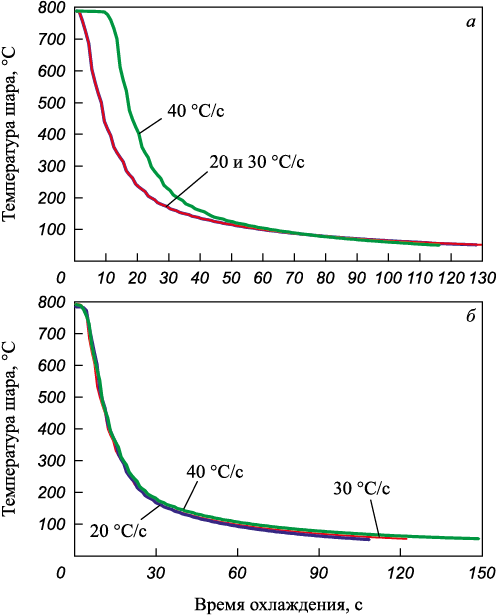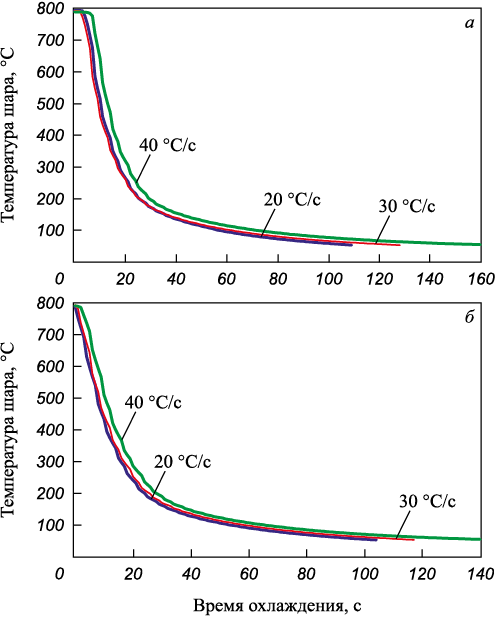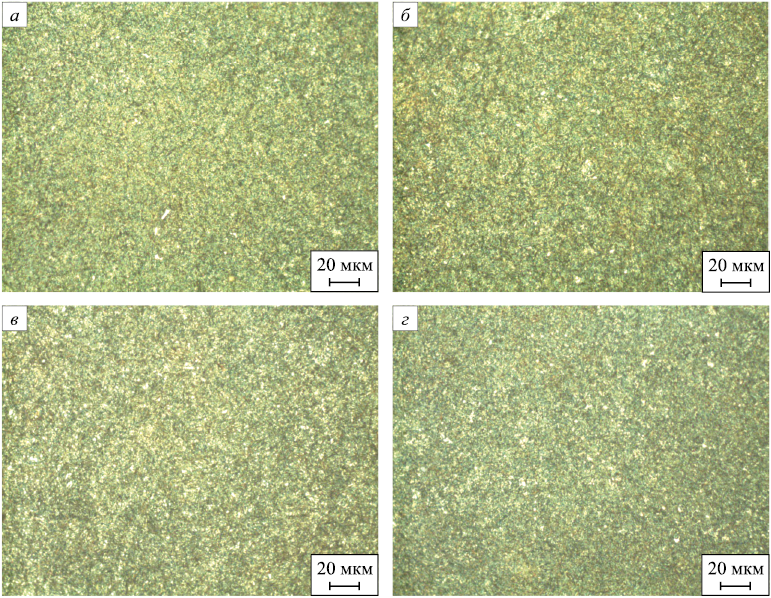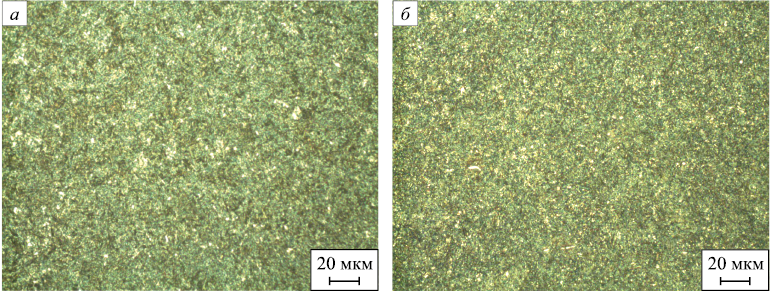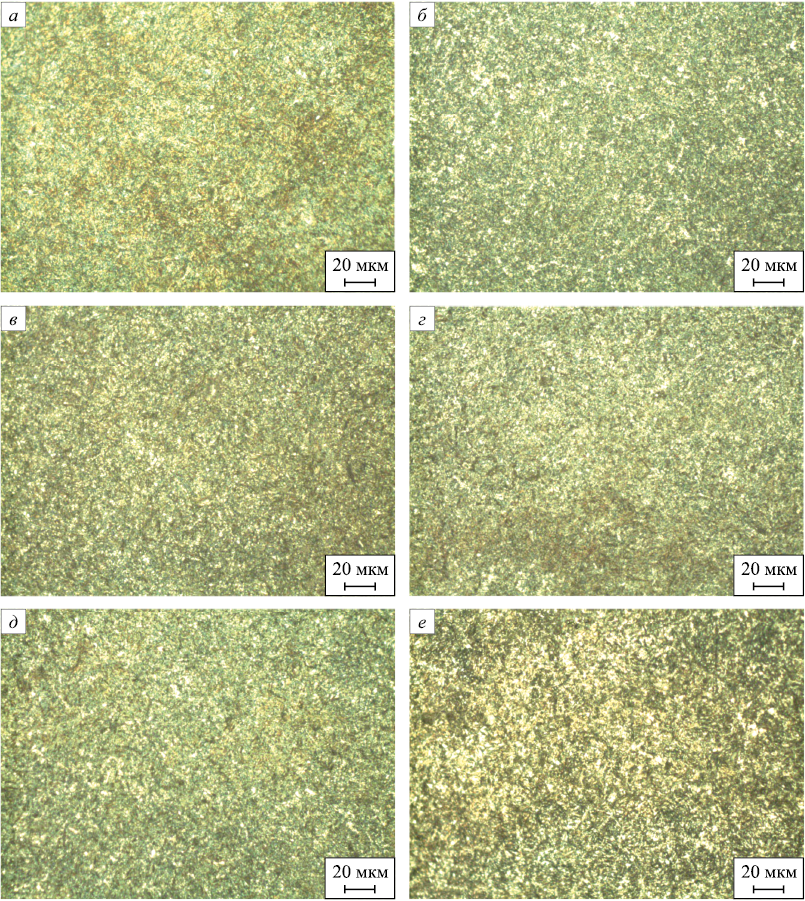Scroll to:
Formation of microstructure in rail steel grinding balls depending on quenching medium parameters
https://doi.org/10.17073/0368-0797-2023-6-645-652
Abstract
Studies of the formation of microstructure of grinding balls from the rejects of rail steel were carried out during their quenching in various polymer media. At the first stage, based on studies of the cooling capacity of solutions of polymers PCM and Thermovit with varying concentrations and temperatures, the authors constructed the cooling curves of grinding balls made of K76F rail steel. It was found that at concentration of these polymers in an aqueous solution of 2 and 4 %, cooling rate of grinding balls made of K76F steel is almost identical at solution temperatures of 20 and 30 °C and significantly decreases when the temperature of the polymer solution increases to 40 °C. At the same time, the most noticeable decrease in the cooling rate is characteristic of PCM polymer with its concentration at the level of 2 %. At the second stage, the authors carried out metallographic studies of the microstructure of grinding balls made of K76F rail steel, which were quenched in laboratory conditions using polymers PCM and Thermovit with concentrations of 2 – 4 % and temperature of 20 – 40 °C. As a result, it was determined that the use of the PCM solution for quenching balls provides a significantly higher quality of microstructure and hardness of heat-treated balls compared to the use of the Thermovit polymer. At the same time, varying the concentration and temperature of the PCM polymer quenching medium allows one to obtain grinding balls with different performance characteristics that determine the potential areas of their application. Thus, quenching of balls in a solution of the specified polymer with concentration of 2 % and temperature of 20 – 30 °C ensures the production of balls with high hardness (corresponding to the IV hardness group according to the state standard GOST 7524 – 2015), and the use of a solution of the same polymer with concentration of 4 % and temperature of 20 – 30 °С for quenching creates the possibility of producing balls with lower hardness, but potentially high impact resistance.
Keywords
For citations:
Umanskii A.A., Baidin V.V., Simachev A.S., Dumova L.V., Safonov S.O. Formation of microstructure in rail steel grinding balls depending on quenching medium parameters. Izvestiya. Ferrous Metallurgy. 2023;66(6):645-652. https://doi.org/10.17073/0368-0797-2023-6-645-652
Introduction
In recent years, there has been a noticeable trend towards the intensive development of domestic ball rolling production. Several modern ball rolling mills have been commissioned [1; 2], and significant efforts are underway at various operational mills to enhance the technological processes for grinding ball production [3 – 6]. This phenomenon is attributed to the growing demand for grinding balls with superior performance characteristics, specifically hardness, wear resistance, and resistance to shock loads. This demand arises from the desire to extend the service life of grinding balls used in the metallurgical, mining, and cement industries. Prolonging the service life significantly reduces the cost of the final product and enhances its quality [7 – 9]. Cost reduction is achieved through a decrease in the specific consumption of balls, while quality improvement results from minimizing the entry of broken ball particles into the crushed materials [10].
An analysis of materials from both domestic and foreign researchers indicates that the enhancement of hardness and impact resistance in balls is primarily achieved through the optimization of the chemical composition of steels employed in ball production [11 – 13]. Additionally, improvements in heat treatment modes play a crucial role in achieving these properties [14 – 16]. It is noteworthy that, aside from the mentioned characteristics, the impact resistance of grinding balls is significantly affected by the quality of their macrostructure [17; 18].
The steels used for the production of grinding balls can be categorized into two main groups based on their chemical composition [19; 20]:
– specialized ball steel;
– steels initially designed for the production of other types of rolled products (either carbon or alloyed).
It’s worth noting that within the second group of steels, a substantial portion consists of rejected rail steel blanks [21 – 23].
The technologies for the heat treatment of grinding balls can be categorized into three main organizational options:
1) hardening followed by self-tempering of the balls in the air;
2) hardening followed by low tempering;
3) “interrupted hardening” (hardening in several stages), followed by low tempering.
The second and third options for the heat treatment of balls are deemed more preferable, as they facilitate the alleviation of quenching stresses [24; 25]. However, implementing the third option is more challenging.
Irrespective of the chosen heat treatment option for grinding balls, the development of their high-quality quenching microstructure is largely influenced by the cooling capacity of the quenching medium employed. Polymers emerge as the most promising type of quenching medium, as their cooling ability can be effectively regulated across a wide range by adjusting water dilution at different concentrations.
In summary, it can be affirmed that investigations into the processes governing the formation of the quenching microstructure in grinding balls made of rail steel using polymer quenching media are currently of significant scientific and practical interest.
Materials and methods
The research focused on grinding balls that had not undergone heat treatment, selected from the mill line after rolling but before hardening, sourced from the current production of JSC Guryev Metallurgical Plant and made from rejected rail steel grade K76F.
The research was carried out in two stages:
1 – examination of the cooling effectiveness of PCM and Thermovit polymer quenching media on the Kompaton facility, with variations in polymer concentration and temperature;
2 – investigation of the microstructure of grinding balls after quenching using PCM and Thermovit polymer quenching media, with variations in their concentration and temperature.
The temperature of the cooling medium varied in the range of 20 – 40 °C with increments of 10 °C, and the concentration of each studied polymer was set at 2 and 4 %.
The Kompaton facility used in the research is equipped with a digital thermometer featuring a temperature sensor. The temperature was recorded at specified intervals in automatic mode, and the TC Soft program was employed for data processing, enabling the construction of cooling curves.
To assess the cooling effectiveness of polymer quenching media, grinding balls were heated in a laboratory furnace to the quenching temperature and subsequently cooled in a tank filled with the respective quenching medium. The hardening temperature was maintained 30 °C higher than the Aс3 point, taking into account the actual chemical composition factoring in the actual chemical composition of the samples, as determined by X-ray spectral analysis using the Shimadzu XRF-1800 spectrometer. The actual heating temperature of the samples for quenching fell within the range of 790 – 802 °C, with a low tempering temperature ranging between 195 – 215 °С.
Microstructure and hardness studies of the balls were conducted on samples that underwent heat treatment. For each ball, one portion underwent quenching, while the other underwent quenching followed by low tempering. The microstructure analysis utilized an OLYMPUS GX-51 optical metallographic microscope, and hardness was determined using a TK-2M hardness tester.
Results and discussion
The analysis of the obtained cooling curves for grinding balls made of K76F rail steel suggests that, with both PCM and Thermovit polymer quenching media, the cooling rate remains practically identical at solution temperatures of 20 and 30 °C, regardless of their concentrations (2 or 4 %). However, a noticeable decrease in the cooling rate is observed when the polymer solution temperature is increased to 40 °C (Figs. 1 and 2). Notably, the most pronounced decrease in the cooling rate is observed with the PCM polymer at a concentration of 2 %.
Fig. 1. Cooling curves of K76F rail steel during quenching
Fig. 2. Cooling curves of K76F rail steel during quenching |
Examination of the microstructure of grinding balls after a complete heat treatment cycle (quenching + low tempering) reveals that the most optimal microstructure, comprising martensite + carbides with some residual austenite, is achieved under specific quenching medium parameters:
1) at a PCM concentration of 2 % and a solution temperature of 20 and 30 °C (Fig. 3, а, b);
2) at a PCM concentration of 4 % and a polymer temperature of 40 °C (Fig. 3, c);
3) at a Thermovit polymer concentration of 4 % and a temperature of 20 °C (Fig. 3, d).
Fig. 3. Microstructure of grinding balls made of K76F rail steel after quenching |
Simultaneously, the highest hardness, aligning with hardness group IV as per the state standard GOST 7524–2015 (refer to the Table), is exhibited by balls hardened using the first set of hardening medium parameters (PCM concentration 2 %, solution temperature 20 and 30 °C). Grinding balls hardened by employing the parameters of the quenching medium according to the second and third options only meet the criteria for hardness group II, as per GOST 7524–2015 (PCM concentration 4 %, temperature 40 °C; Thermovit concentration 4 %, temperature 20 °С).
Comparative analysis of hardness of the balls
| ||||||||||||||||||||||||||||||||||||||||||||||||||||||||||||||||||||||||||||||||||||||||
When a 4 % PCM polymer solution is utilized for hardening balls at temperatures of 20 and 30 °C, a microstructure in the form of troostomartensite + carbides + residual austenite is formed (Fig. 4). Although the hardness of such balls falls within hardness group II according to GOST 7524–2015 (refer to the Table), they exhibit potentially higher impact strength owing to the properties of the troostomartensite phase.
Fig. 4. Microstructure of grinding balls made of K76F rail steel |
However, quenching balls according to other combinations of quenching medium parameters results in a defective microstructure. In addition to martensite, there is the presence of quenching troostite in various forms: acicular, spheroidal, and in the form of a network (Fig. 5). The existence of troostite in the structure indicates a lower cooling rate, signifying inadequate cooling capacity of the quenching medium. Regardless of the type of troostite, its negative impact on the hardness of the grinding balls is evident (refer to the table). Notably, the more pronounced negative influence is naturally exerted by the spheroidal troostite and the form of a grid.
Fig. 5. Defective microstructure of grinding balls made of K76F rail steel |
In general, it is noteworthy that the quality of the microstructure in balls hardened with PCM solution is significantly superior compared to those hardened with Thermovit polymer solution. For instance, balls hardened in a PCM solution with a 2 % concentration at a temperature of 40 °C exhibit only acicular troostite in the structure (Fig. 5, a); balls hardened with Thermovit polymer at a similar concentration and temperature display spheroidal troostite and troostite in the form of a grid (Fig. 5, c). Moreover, the hardness of balls hardened using PCM polymer with the specified concentration and temperature, both on the surface and in the core, is, on average, 6 – 7 HRC higher than the hardness of balls hardened in Thermovit polymer medium (refer to the Table).
In conclusion, it can be inferred that altering the parameters of the polymer quenching medium enables the variation of performance characteristics in grinding balls made of rail steel, thus determining potential applications. For example:
• quenching balls in a PCM polymer solution with a 2 % concentration at a temperature of 20 – 30 °C ensures the production of balls with high hardness (hardness group IV as per GOST 7524–2015).
• employing the same polymer solution for quenching with a 4 % concentration and a temperature of 20 – 30 °C creates the possibility of producing balls with lower hardness but potentially high impact resistance.
However, caution is advised as certain combinations of PCM and Thermovit polymer concentrations and temperatures may lead to a high risk of obtaining a defective microstructure.
Conclusions
Based on laboratory experimental studies, cooling curves were constructed for hardening of the balls made of K76F rail steel in solutions of PCM and Thermovit polymers, each with a concentration of 2 and 4 % and temperature ranging from of 20 to 40 °C. The experimental research in the laboratory has elucidated the patterns governing the formation of the microstructure in grinding balls from the specified steel when utilizing PCM and Thermovit polymer quenching media with varying heat treatment parameters.
Notably, the use of PCM solution for ball hardening ensures a significantly higher quality of the microstructure and hardness of the balls compared to utilization of Thermovit polymer. As a result, recommendations have been developed for optimal combinations of concentration and temperature of PCM polymer. These recommendations aim to ensure the production of balls with increased hardness as well as the production of balls with lower hardness but with a heightened level of impact resistance.
References
1. Ulegin K.A., Shvedov K.N., Borodin A.N., Rubtsov V.Yu. The new ball-rolling mill of EVRAZ NTMK – new possibilities for customers. Ferrous Metallurgy. Bulletin of Scientific, Technical and Economic Information. 2020;76(6):602–608. (In Russ.). https://doi.org/10.32339/0135-5910-2020-6-602-608
2. Shvedov K.N., Galim’yanov I.K., Kazakovtsev M.A. Production of grinding balls of high surface and normalized volume hardness. Metallurgist. 2020;64(5–6):499–507. http://dx.doi.org/10.1007/s11015-020-01019-3
3. Stalinskii D.V., Rudyuk A.S., Solenyi V.K., Yudin A.V., Volkov K.V., Atkonova O.P. Improving the production of steel grinding balls at AO EVRAZ ZSMK. Steel in Translation. 2016;46(7):525–528. https://doi.org/10.3103/S0967091216070135
4. Lam M.M., Serov A.I., Smyrnov Y.N., Ternavskii A.N., Mykheiev V.V. Production of hard (class V) grinding balls at PJSC “DMPZ”. Steel in Translation. 2017;47(5):325–329. https://doi.org/10.3103/S0967091217050072
5. Adigamov R.R., Nikishin I.A., Zhitelev P.S., Andreev A.R., Karlina A.R. Experience in mastering the production of steel grinding balls in PJSC SEVER-STAL. Stal’. 2022;(3):13–18. (In Russ.).
6. Lam M.M., Serov A.I., Smirnov E.N., Ternavskii A.A., Bazarova G.S. Mastering the production of 40- and 60-mm-diam. grinding balls in hardness classes III and IV at the Donetsk Metal-Rolling Plant. Metallurgist. 2016;60(3-4): 440–446. http://dx.doi.org/10.1007/s11015-016-0311-x
7. Aldrich C. Consumption of steel grinding media in mills – A review. Minerals Engineering. 2013;49:77–91. http://dx.doi.org/10.1016/j.mineng.2013.04.023
8. Umucu Y., Deniz V. The effect of ball type in fine particles grinding on kinetic breakage parameters. Inzynieria Mineralna. 2015;16(1):197–203.
9. Song Z., Pu Y., Liu Z., Wang B. Analysis of failure of grinding balls during service. Metal Science and Heat Treatment. 2022;64(1-2):127–133. https://doi.org/10.1007/s11041-022-00772-3
10. Rakhutin M., Boiko P. Ways to improve assessment methods of the main characteristics of grinding balls. Ugol’. 2017;(12):49–52. http://dx.doi.org/10.18796/0041-5790-2017-12-49-52
11. Naizabekov A.B., Mukhametkaliev B.S., Arbuz A.S., Lezhnev S.N. Reducing the consumption of steel grinding balls by improving their production technology. Vesti vysshikh uchebnykh zavedenii Chernozem’ya. 2016;4(46): 78–86. (In Russ.).
12. Sychkov A.B., Steblov A.B., Bereznov S.N. The choice of material and heat treatment regimes of steel grinding balls, meeting the requirements of the modern global market. Lit’e i metallurgiya. 2013;(3(71)):30–32. (In Russ.).
13. Umansky A.A., Golovatenko A.V., Prudnikov A N. Analysis of the main trends in the development of the production of grinding balls in Russia and abroad. IOP Conference Series: Materials Science and Engineering. 2020;866(1):012032. http://dx.doi.org/10.1088/1757-899X/866/1/012032
14. Bai X., Jin Y. Heat treatment of wear resistant steel ball for large ball mill. Jinshu Rechuli/Heat Treatment of Metals. 2017;42(5):193–196. https://doi.org/10.13251/j.issn.0254-6051.2017.05.040
15. Bouhamla K., Bourebia M., Gharbi A., Maouche H., Chaour M., Belhadi S. Effect of heat treatment on tribological behavior of forged steel balls. AIP Conference Proceedings. 2019;2123(1):030004. https://doi.org/10.1063/1.5117035
16. Titov S.S., Meshcheryakov V.N., Leushin I.O., Fedorov O.V. Development of technology and equipment for induction axisymmetric hardening of grinding steel balls. Chernye metally. 2020;(6):11–16. (In Russ.).
17. Smirnov E.N., Smirnov A.N., Mikheev V.V., Sklyar V.A., Belevitin V.A., Verzilov A.P., Orlov G.A. The exploration of the possibility of using continuous-cast 55 grade steel in the manufacturing of 40-mm-in-diameter grinding balls of IV and V hardness class. Steel in Translation. 2020;50(4): 270–276. https://doi.org/10.3103/S0967091220040099
18. Stalinskii D.V., Rudyuk A.S., Solenyi V.K. Development of production and estimation of the efficiency of using high-quality grinding balls. Report 1. Mastering the production of balls from chromium–molybdenum steel. Steel in Translation. 2021;51(11):822–826. https://doi.org/10.3103/S0967091221110127
19. Efremenko V.G. Metallographic analysis of the causes of destruction of steel rolled bodies for drum mills. Vestnik Priazovskogo gosudarstvennogo tekhnicheskogo universiteta. 2000;(9):89–91. (In Russ.).
20. Umanskii A.A., Temlyantsev M.V., Oskolkova T.N., Simachev A.S., Golovatenko A.V. Study of grinding ball quality properties during manufacture in a screw rolling mill. Metallurgist. 2019;63(5-6):578–584. http://dx.doi.org/10.1007/s11015-019-00863-2
21. Pater Z., Tomczak J., Bulzak T., Andrietti S., Barbelet M. An innovative method for producing balls from scrap rail heads. The International Journal of Advanced Manufacturing Technology. 2018;97(1-4):893–901. https://doi.org/10.1007/s00170-018-2007-9
22. Tomczak J., Pater Z., Bulzak T. The flat wedge rolling mill for forming balls from heads of scrap railway rails. Archives of Metallurgy and Materials. 2018;63(1):5–12. http://dx.doi.org/10.24425/118901
23. Umanskiy A.A., Simachev A.S., Dumova L.V. Development of technology for production of grinding bodies with improved performance properties from the rail steels rejection. Chernye Metally. 2021;(5):57–61. http://doi.org/10.17580/chm.2021.05.10
24. Efremenko V.G., Popov E.S., Kuz’min S.O., Trufanova O.I., Efremenko А.V. Introduction of three-stage thermal hardening technology for large diameter grinding balls. Metallurgist. 2014;57(9-10):849–854. http://doi.org/10.1007/s11015-014-9812-7
25. Zurnadzhy V.I., Efremenko V.G., Wu K.M., Lekatou A.G, Shimizu K., Chabak Yu.G., Zotov D.S., Dunayev E.V. Quenching and partitioning–based heat treatment for rolled grinding steel balls. Metallurgical and Materials Transactions A. 2020;51(1-4):3042–3053. https://doi.org/10.1007/s11661-020-05737-w
About the Authors
A. A. UmanskiiRussian Federation
Aleksandr A. Umanskii, Dr. Sci. (Eng.), Prof. of the Chair of Ferrous Metallurgy
42 Kirova Str., Novokuznetsk, Kemerovo Region – Kuzbass 654007, Russian Federation
V. V. Baidin
Russian Federation
Vadim V. Baidin, Candidates for a degree of Сand. Sci. (Eng.) of the Chair of Ferrous Metallurgy
42 Kirova Str., Novokuznetsk, Kemerovo Region – Kuzbass 654007, Russian Federation
A. S. Simachev
Russian Federation
Artem S. Simachev, Cand. Sci. (Eng.), Assist. Prof. of the Chair “Metal Forming and Metal Science. “EVRAZ ZSMK”
42 Kirova Str., Novokuznetsk, Kemerovo Region – Kuzbass 654007, Russian Federation
L. V. Dumova
Russian Federation
Lyubov’ V. Dumova, Candidates for a degree of Сand. Sci. (Eng.) of the Chair of Ferrous Metallurgy
42 Kirova Str., Novokuznetsk, Kemerovo Region – Kuzbass 654007, Russian Federation
S. O. Safonov
Russian Federation
Sergei O. Safonov, Assistant of the Chair of Ferrous Metallurgy
42 Kirova Str., Novokuznetsk, Kemerovo Region – Kuzbass 654007, Russian Federation
Review
For citations:
Umanskii A.A., Baidin V.V., Simachev A.S., Dumova L.V., Safonov S.O. Formation of microstructure in rail steel grinding balls depending on quenching medium parameters. Izvestiya. Ferrous Metallurgy. 2023;66(6):645-652. https://doi.org/10.17073/0368-0797-2023-6-645-652



